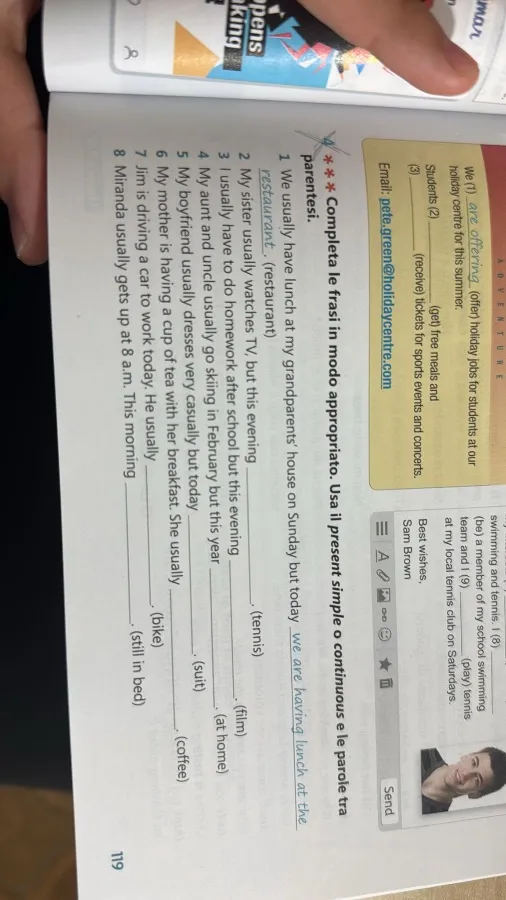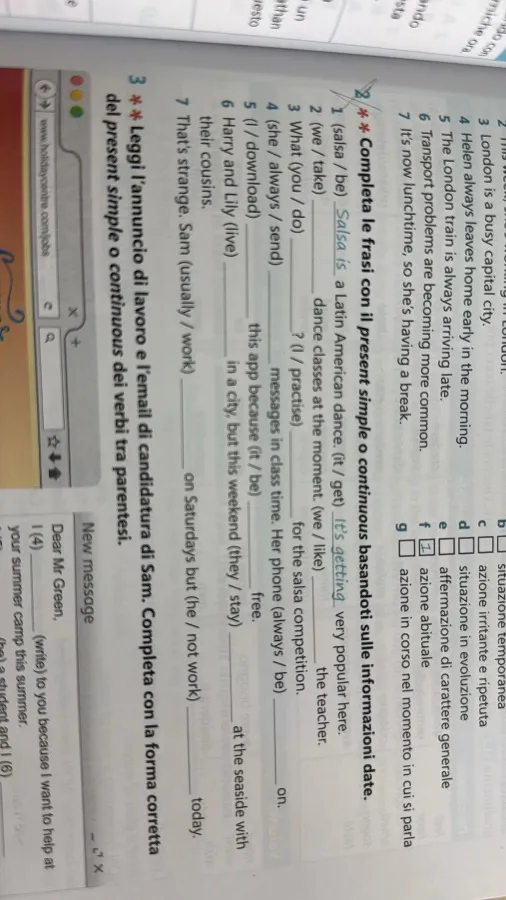Present Simple vs Present Continuous Exercises

Certamente! Risolverò gli esercizi uno per uno, fornendo spiegazioni dettagliate.
Задание 1
La frase di partenza è: "We usually have lunch at my grandparents' house on Sunday but today..." e la parola tra parentesi è "restaurant".
Spiegazione:
La frase descrive un'azione abituale ("usually have lunch") che viene contrastata con un'azione specifica che avviene "today". Quindi, dobbiamo usare il present continuous per l'azione di oggi.
Soluzione:
We usually have lunch at my grandparents' house on Sunday but today we are having lunch at the restaurant.
Задание 2
La frase di partenza è: "My sister usually watches TV, but this evening..." e la parola tra parentesi è "tennis".
Spiegazione:
Anche qui, abbiamo un contrasto tra un'azione abituale ("usually watches TV") e qualcosa che sta succedendo "this evening". Dobbiamo usare il present continuous per l'azione di questa sera.
Soluzione:
My sister usually watches TV, but this evening she is playing tennis.
Задание 3
La frase di partenza è: "I usually have to do homework after school but this evening..." e la parola tra parentesi è "film".
Spiegazione:
Simile agli esempi precedenti, c'è un contrasto tra l'abitudine di fare i compiti e l'azione specifica di "this evening". Usiamo il present continuous.
Soluzione:
I usually have to do homework after school but this evening I am watching a film.
Certamente! Ecco altri esempi di frasi simili che utilizzano il present simple e il present continuous per esercitarti:
Задание 4
La frase di partenza è: "My aunt and uncle usually go skiing in February but this year..." e la parola tra parentesi è "at home".
Spiegazione:
Come prima, c'è un contrasto tra un'azione abituale ("usually go skiing") e un'azione specifica che avviene "this year". Dobbiamo usare il present continuous per l'azione di quest'anno.
Soluzione:
My aunt and uncle usually go skiing in February but this year they are staying at home.
Задание 5
La frase di partenza è: "My boyfriend usually dresses very casually but today..." e la parola tra parentesi è "suit".
Spiegazione:
Anche qui, abbiamo un contrasto tra un'azione abituale ("usually dresses very casually") e qualcosa che sta succedendo "today". Dobbiamo usare il present continuous per l'azione di oggi.
Soluzione:
My boyfriend usually dresses very casually but today he is wearing a suit.
Задание 6
La frase di partenza è: "My mother is having a cup of tea with her breakfast. She usually..." e la parola tra parentesi è "coffee".
Spiegazione:
In questo caso, l'azione al present continuous è all'inizio ("My mother is having a cup of tea"). Quindi, l'azione abituale deve essere al present simple.
Soluzione:
My mother is having a cup of tea with her breakfast. She usually drinks coffee.
Ассистент: Certo, ecco una spiegazione dettagliata sull'uso del present simple e present continuous, con esempi aggiuntivi:
Present Simple
Uso:
1. Abitudini e routine: Azioni che si ripetono regolarmente.
2. Fatti generali e verità universali: Cose che sono sempre vere.
3. Orari e programmi: Eventi programmati.
Struttura:
* Affermativa: Soggetto + verbo (forma base)
* Negativa: Soggetto + do/does + not + verbo (forma base)
* Interrogativa: Do/Does + soggetto + verbo (forma base)?
Esempi:
- "I usually drink coffee in the morning." (Abitudine)
- "The sun rises in the east." (Verità universale)
- "The train leaves at 9 a.m." (Orario)
Present Continuous
Uso:
1. Azioni che stanno accadendo ora: Azioni in corso nel momento in cui si parla.
2. Azioni temporanee: Azioni che durano per un periodo limitato.
3. Piani futuri: Piani già stabiliti.
Struttura:
* Affermativa: Soggetto + is/am/are + verbo-ing
* Negativa: Soggetto + is/am/are + not + verbo-ing
* Interrogativa: Is/Am/Are + soggetto + verbo-ing?
Esempi:
- "I am studying English now." (Azione in corso)
- "They are staying in a hotel this week." (Azione temporanea)
- "We are going to the cinema tonight." (Piano futuro)
Esercizi aggiuntivi
Completa le seguenti frasi usando il present simple o present continuous:
- Normally, she ______________ (walk) to school, but today she ______________ (take) the bus.
- My parents ______________ (live) in Rome, but they ______________ (visit) me this week.
- He ______________ (play) football every Saturday, but this Saturday he ______________ (work).
- We ______________ (eat) dinner at 7 p.m. every day, but tonight we ______________ (eat) later.
- She ______________ (work) as a teacher, but she ______________ (train) to be a doctor.
Soluzioni:
- walks, is taking
- live, are visiting
- plays, is working
- eat, are eating
- works, is training

Ассистент: Certamente! Risolverò gli esercizi uno per uno, fornendo spiegazioni dettagliate.
Задание 7
La frase di partenza è: "Jim is driving a car to work today. He usually..." e la parola tra parentesi è "bike".
Spiegazione:
La prima parte della frase è al present continuous ("Jim is driving"), quindi la seconda parte, che descrive un'azione abituale, deve essere al present simple.
Soluzione:
Jim is driving a car to work today. He usually bikes.
Задание 8
La frase di partenza è: "Miranda usually gets up at 8 a.m. This morning..." e la parola tra parentesi è "still in bed".
Spiegazione:
Abbiamo un contrasto tra l'azione abituale ("usually gets up") e l'azione specifica di "this morning". Dobbiamo usare il present continuous per l'azione di questa mattina.
Soluzione:
Miranda usually gets up at 8 a.m. This morning she is still in bed.
Задание 1 (seconda immagine)
La frase di partenza è: "Salsa (to be) a Latin American dance. (to get) very popular here."
Spiegazione:
La prima parte della frase descrive un fatto generale, quindi usiamo il present simple del verbo "to be". La seconda parte descrive un'azione in corso, quindi usiamo il present continuous del verbo "to get".
Soluzione:
Salsa is a Latin American dance. It is getting very popular here.
Ассистент: Certo, ecco una spiegazione dettagliata sull'uso del present simple e present continuous in queste frasi, con esempi aggiuntivi:
Present Simple
Uso:
1. Abitudini e routine: Azioni che si ripetono regolarmente.
2. Fatti generali e verità universali: Cose che sono sempre vere.
3. Orari e programmi: Eventi programmati.
Struttura:
* Affermativa: Soggetto + verbo (forma base)
* Negativa: Soggetto + do/does + not + verbo (forma base)
* Interrogativa: Do/Does + soggetto + verbo (forma base)?
Esempi:
- "I usually drink coffee in the morning." (Abitudine)
- "The sun rises in the east." (Verità universale)
- "The train leaves at 9 a.m." (Orario)
Present Continuous
Uso:
1. Azioni che stanno accadendo ora: Azioni in corso nel momento in cui si parla.
2. Azioni temporanee: Azioni che durano per un periodo limitato.
3. Piani futuri: Piani già stabiliti.
Struttura:
* Affermativa: Soggetto + is/am/are + verbo-ing
* Negativa: Soggetto + is/am/are + not + verbo-ing
* Interrogativa: Is/Am/Are + soggetto + verbo-ing?
Esempi:
- "I am studying English now." (Azione in corso)
- "They are staying in a hotel this week." (Azione temporanea)
- "We are going to the cinema tonight." (Piano futuro)
Esercizi aggiuntivi
Completa le seguenti frasi usando il present simple o present continuous:
- Normally, she ______________ (walk) to school, but today she ______________ (take) the bus.
- My parents ______________ (live) in Rome, but they ______________ (visit) me this week.
- He ______________ (play) football every Saturday, but this Saturday he ______________ (work).
- We ______________ (eat) dinner at 7 p.m. every day, but tonight we ______________ (eat) later.
- She ______________ (work) as a teacher, but she ______________ (train) to be a doctor.
Soluzioni:
- walks, is taking
- live, are visiting
- plays, is working
- eat, are eating
- works, is training
Ассистент: Certo, ecco le soluzioni degli esercizi rimanenti:
Задание 2 (seconda immagine)
La frase di partenza è: "(we/take) dance classes at the moment. (we/like) the teacher."
Spiegazione:
La prima parte della frase descrive un'azione che sta accadendo "at the moment", quindi usiamo il present continuous. La seconda parte esprime un'opinione generale, quindi usiamo il present simple.
Soluzione:
We are taking dance classes at the moment. We like the teacher.
Задание 3 (seconda immagine)
La frase di partenza è: "What (you/do) ? (I/practise) for the salsa competition."
Spiegazione:
La prima parte è una domanda su cosa stai facendo in questo periodo, quindi usiamo il present continuous. La seconda parte descrive un'azione che stai facendo per prepararti a qualcosa, quindi usiamo il present continuous.
Soluzione:
What are you doing? I am practicing for the salsa competition.
Задание 4 (seconda immagine)
La frase di partenza è: "(she/always/send) messages in class time. Her phone (always / be) on."
Spiegazione:
La prima parte descrive un'abitudine irritante, quindi usiamo il present continuous con "always". La seconda parte descrive una situazione che si ripete, quindi usiamo il present simple.
Soluzione:
She is always sending messages in class time. Her phone is always on.
Ассистент: Certo, ecco le soluzioni degli esercizi rimanenti:
Задание 5 (seconda immagine)
La frase di partenza è: "(I/download) this app because (it/be) free."
Spiegazione:
La prima parte descrive un'azione che stai facendo, quindi usiamo il present continuous. La seconda parte descrive una caratteristica dell'app, quindi usiamo il present simple.
Soluzione:
I am downloading this app because it is free.
Задание 6 (seconda immagine)
La frase di partenza è: "Harry and Lily (live) in a city, but this weekend (they/stay) at the seaside with their cousins."
Spiegazione:
La prima parte descrive dove vivono di solito, quindi usiamo il present simple. La seconda parte descrive cosa stanno facendo questo fine settimana, quindi usiamo il present continuous.
Soluzione:
Harry and Lily live in a city, but this weekend they are staying at the seaside with their cousins.
Задание 7 (seconda immagine)
La frase di partenza è: "That's strange. Sam (usually/work) on Saturdays but (he / not work) today."
Spiegazione:
La prima parte descrive cosa fa di solito Sam, quindi usiamo il present simple. La seconda parte descrive cosa non sta facendo oggi, quindi usiamo il present continuous.
Soluzione:
That's strange. Sam usually works on Saturdays but he is not working today.





